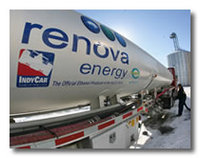IndyCar Series Prepares for Debut of 100 Percent Fuel-Grade Ethanol
 |
INDIANAPOLIS--The IndyCar Series is poised to make motorsports history when it turns the first competitive laps with its 3.5-liter Honda Indy V-8 engine powered by 100 percent fuel-grade ethanol at the XM Satellite Radio Indy 300 on March 24 at Homestead-Miami Speedway.
The IndyCar Series is the first in motorsports to use a renewable fuel, setting the trend for the “Greening of Racing.” Indy car racing had previously used methanol for more than 40 years.
“The IndyCar Series jump to ethanol has been great,” said Tony Kanaan, the series’ 2004 champion. “We are definitely on the right path with ethanol. There is more power with the new (3.5-liter Honda Indy V-8) engine. It runs clean and it is better for the environment. So it is a win-win situation, and that is great for the series. Ethanol is another alternative to gasoline. If we can show that the IndyCar Series cars can run ethanol, then it is good for everyone’s street cars.”
As the IndyCar Series prepares for the competitive debut of ethanol, several themes have developed on and off the track perpetuating the ethanol story:
- Homegrown & American Made: The IndyCar Series is the first in motorsports to use a homegrown fuel. Most U.S. ethanol is made from corn, but the production process is versatile. It works with most sugar-containing plant materials, such as sorghum, wheat, barley and potatoes. In fact, ethanol producers in Brazil use sugar cane to start the process. Renova Energy in Torrington, Wyo., produces ethanol for the IndyCar Series and is one of the more than 110 ethanol plants in production. In 2006, these facilities produced nearly 5.4 billion gallons of ethanol - enough to enrich 46 percent of all gasoline sold in the United States. Currently, there are more than 75 ethanol plants under construction in the U.S.
- High-Performance: Ethanol in high-performance vehicles has been one of the renewable fuel’s most attractive qualities and best kept secrets. With racing machines that reach speeds in excess of 230 mph on 100 percent fuel-grade ethanol, the IndyCar Series is the ultimate challenge for ethanol as a performance fuel, illustrating a higher octane rating (113 to methanol’s 107), a high flash point (55.4º F to 52º F) and a larger energy content (77,000 BTU per gallon to 64,250 BTU per gallon). Ethanol’s positive energy balance means the energy source produced gives back more energy than it took to create it. And that balance helps give the IndyCar Series cars a positive feel on and off the track.
- Environmentally Friendly: Ethanol is a cleaner energy source that has been shown to reduce harmful air pollution by reducing carbon dioxide and other greenhouse gas emissions. The IndyCar Series previously had used methanol, a fuel produced from natural gas, a non-renewable source. Since ethanol is produced from agricultural products that can be replanted, such as corn, the supply can continually be replenished. It is also 100 percent biodegradable, meaning it won’t harm groundwater. Even the co-products from the ethanol production process at the nation’s 110 ethanol plants, including IndyCar Series supplier Renova Energy in Torrington, Wyo., don’t go to waste. The leftover grain is used as a highly nutritious livestock feed and carbon dioxide that is produced is sold to the carbon beverage and dry ice industries.
- Marketing Activation: The Ethanol Promotion and Information Council (EPIC) has been fine tuning its first-ever national marketing campaign around its partnership with the IndyCar Series. As part of its marketing activation EPIC has created a mobile marketing unit that will travel to all 16 domestic IndyCar Series events in 2007 and will be located in each track’s midway area. EPIC’s television partnership with ABC/ESPN is its first on any national level and features IndyCar Series-specific commercial that will run during IndyCar Series telecasts. EPIC also has committed to local advertising buys in race markets. Additionally, EPIC will continue with its Pump Tours, allowing consumers to buy E10 fuel in race markets at a reduced price. The tours include IndyCar Series drivers and serve as an initiation for many consumers to an ethanol-enriched product.
The IndyCar Series opens its ethanol-powered season on March 24 under the lights at Homestead-Miami Speedway. All 17 races on the 2007 schedule, including the Indianapolis 500, will be run on 100 percent fuel-grade ethanol.



